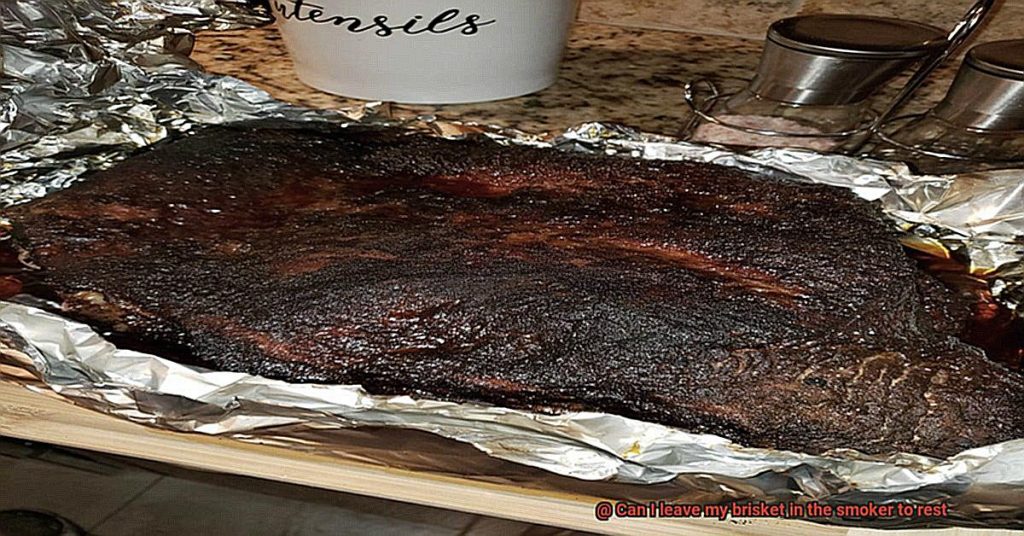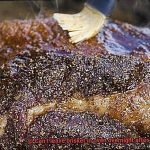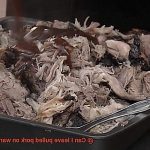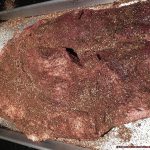Imagine this: You’ve poured your heart and soul into that brisket, babying it for hours on end. The smoke dances around, teasing your senses with its mouthwatering aroma. And now, you’re faced with a burning question: Can I leave my brisket in the smoker to rest? Well, my friend, get ready to embark on a journey through the mesmerizing world of barbecue wizardry. In this blog post, we’re going to unravel the mysteries behind why resting your brisket in the smoker is an absolute game-changer. We’ll explore how this secret technique can take your brisket from good to legendary. So grab a comfy spot and prepare to unlock the full potential of your smoked masterpiece.
Contents
What is Brisket?
Brisket, a tantalizing cut of meat from the breast or lower chest area of a cow, has earned its reputation for being tough yet bursting with flavor. Join us as we dive into the depths of what brisket truly is and uncover the secrets to transforming it into a tender, juicy masterpiece through the power of smoke.
The Anatomy of Brisket:
Brisket can be divided into two parts: the flat and the point. The flat, leaner and more uniform in shape, offers a firm texture that is perfect for slicing. On the other hand, the point boasts an irregular shape with generous marbling and pockets of delicious fat, resulting in a succulent and melt-in-your-mouth experience.
Preparing for Smoking:
Before immersing your brisket into a smoky paradise, some preparation is required. Trim away any excess fat from the surface to allow for better smoke penetration and prevent greasiness. Elevate the flavors to new heights by applying a dry rub or marinade, experimenting with various spice blends or crafting your own signature concoction.
The Symphony of Smoke:
The key to unlocking the full potential of brisket lies in low and slow cooking techniques. Maintaining an unwavering temperature between 225°F and 250°F (107°C – 121°C) throughout the smoking process is crucial for achieving optimal tenderness and flavor development. Patience is essential during the stall stage, where the internal temperature plateaus momentarily as moisture evaporates from the meat’s surface, creating an otherworldly bark.
Resting:
Once your brisket has reached its desired internal temperature, it’s time to let it rest. This crucial step allows the juices to redistribute, resulting in a succulent and moist final product. Some pitmasters prefer resting their brisket in the smoker with the heat turned off, while others choose to wrap it in foil or butcher paper for a gentler environment. A minimum resting time of 30 minutes to an hour is recommended, though some enthusiasts opt for several hours to intensify the flavors even further.
The Grand Finale:
Slicing your perfectly smoked brisket is an art form in itself. Remember to cut against the grain to ensure tender, tantalizing bites. Enhance the experience by serving your masterpiece with your favorite barbecue sauce or let the inherent flavors shine on their own, showcasing the true essence of brisket.
Benefits of Resting Brisket
Resting brisket after smoking is a crucial step in the quest for perfection. It may seem tempting to dive right into that smoky, juicy goodness, but let me tell you about the magical benefits of giving your brisket some well-deserved rest.
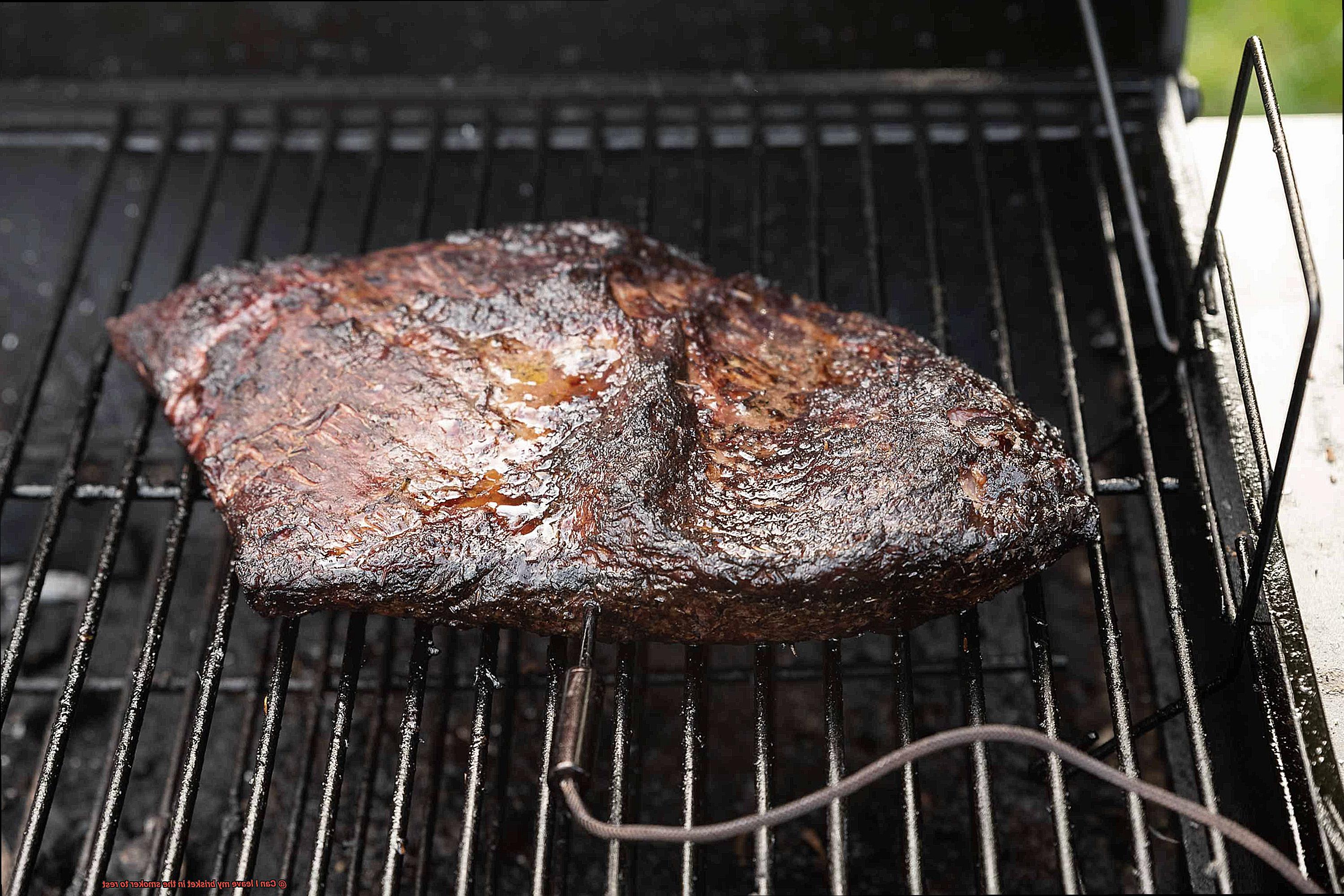
First and foremost, resting allows the brisket to reabsorb its precious juices. When heat is applied to this beefy behemoth, it tends to squeeze out flavorful moisture. But fear not. Resting gives those droplets a chance to redistribute and get soaked right back into the meat. The result? A juicier, more flavor-packed final product that will have you doing a happy dance with every bite.
But the benefits don’t stop there. Resting also works its tenderizing magic on your brisket. During the cooking process, collagen in the meat breaks down and transforms into gelatinous goodness. However, if you unleash your knife immediately after cooking, you risk losing some of that tender texture. By giving your brisket some well-deserved rest time, the collagen can reabsorb moisture and create a melt-in-your-mouth experience that will make your taste buds sing.
Resting also enhances flavor in ways you can’t even imagine. As your brisket takes a breather, its internal temperature continues to rise slightly due to residual heat – think of it as a culinary power nap. This gentle carryover cooking helps intensify flavors and allows them to mingle together beautifully. Plus, while resting, any seasonings or rubs on the surface of the brisket have time to penetrate deeper into the meat, creating an explosion of taste that will leave you craving more.
But let’s talk practicality. Resting your brisket makes slicing a breeze. Picture this: a hot, unruly slab of meat that tears and shreds at the mere sight of a blade. Not ideal, right? By giving your brisket time to cool down slightly, you’ll find it much easier to achieve those neat and even slices that will make you look like a pro pitmaster.
And let’s not forget about presentation, because we eat with our eyes first. When you slice into a rested brisket, it retains its shape better and maintains its structural integrity. Each slice becomes a work of art, visually appealing and oh-so-satisfying. So if you’re planning to impress your guests with your culinary skills, resting is an absolute must.
But hey, resting isn’t just about the end result – it’s also about managing the cooking process itself. By factoring in a resting period, you gain flexibility in your cooking schedule, ensuring that everything is ready to be served at the same time. Resting allows for better timing and reduces stress when preparing a large cut of meat like a brisket.
Length of Time Needed for Resting
Resting a brisket is a crucial step in the cooking process, allowing the meat to reach its full potential of tenderness and flavor. The length of time needed for resting can vary depending on several factors, including the size of the brisket, cooking temperature, and personal preference.
As a general guideline, it is recommended to let a brisket rest for at least 30 minutes to an hour before slicing and serving. This brief rest allows the meat to cool down slightly and allows the juices to settle, resulting in a more succulent and flavorful bite.
However, some pitmasters and barbecue enthusiasts swear by longer resting periods, ranging from 1 to 4 hours or even overnight. This extended resting time further enhances the tenderness and juiciness of the brisket, creating an unbelievably melt-in-your-mouth experience. To keep those precious juices locked in during this time, tightly wrap the brisket in aluminum foil or butcher paper.
It’s important to note that during the resting period, the internal temperature of the brisket will continue to rise slightly due to residual heat. Therefore, it is crucial to remove the brisket from the smoker when it reaches an internal temperature about 10 degrees Fahrenheit lower than your desired doneness. This ensures that the meat doesn’t overcook during resting.
Ultimately, the choice of resting time depends on personal preference and desired texture. Some prefer a firmer texture and may opt for shorter resting periods, while others crave that tender and juicy result, necessitating longer resting times. Experimentation and practice are key to finding your ideal resting time, so start conservatively and adjust based on your taste buds.
Leaving the Brisket in the Smoker During Resting
Leaving the brisket in the smoker during resting is a technique that has its advantages and disadvantages. One of the main advantages is that it allows the brisket to continue cooking gently and evenly. The residual heat in the smoker helps maintain a consistent temperature, ensuring that your meat remains moist and tender throughout. This continued cooking also helps with the redistribution of juices within the meat. As the brisket cools down, the muscle fibers relax, allowing those savory juices to flow back into every delicious bite.
Another advantage of leaving the brisket in the smoker is that it helps retain moisture. When properly wrapped in foil or butcher paper, the brisket creates a steamy environment, preventing moisture loss. This enhances the tenderness and juiciness of the final product, resulting in melt-in-your-mouth goodness.
However, there are also potential disadvantages to consider. One risk is overcooking the brisket if the smoker temperature is too high during resting. To avoid this, it’s crucial to monitor and adjust the temperature accordingly.
Another risk is drying out the brisket if it’s not properly wrapped or left in the smoker for too long. This can result in a dry and less flavorful brisket, which is definitely not what we’re aiming for.
As an alternative to leaving the brisket in the smoker, some pitmasters prefer to transfer it to an insulated container, such as a cooler or Cambro, for resting. This method retains heat and moisture more effectively than leaving it in the smoker.
In terms of resting time, a minimum of 30 minutes is recommended, but many pitmasters prefer resting for up to 2 hours or longer. Finding what works best for you and your taste preferences is key.
Temperature Considerations During Resting
Resting your brisket after it has been cooked is a crucial step in the grilling process. It allows the flavors to mingle, the juices to redistribute, and the meat to become even more tender and succulent. But did you know that temperature considerations during this resting period are equally important? Let’s dive into why temperature matters and how you can maintain a safe and delicious brisket.
First and foremost, let’s talk about the internal temperature of the brisket. To achieve that perfect tenderness, the internal temperature should reach around 195-205°F (90-96°C) before you remove it from the smoker. This ensures that the connective tissues have broken down and the meat is tender. But don’t rush into slicing just yet. Give your brisket a well-deserved rest for at least 30 minutes to an hour.
During this resting period, the temperature is critical. You want to keep your brisket warm, but not too hot or too cold. Wrapping it in aluminum foil or butcher paper is a great way to lock in the heat and retain moisture. Once wrapped, place your brisket in a cooler or insulated container. These cozy retreats will help maintain the desired temperature while allowing the meat to continue cooking internally.
But why is temperature so important during resting? Well, there’s a little thing called food safety. The minimum recommended temperature for cooked food is 140°F (60°C), and you want to make sure your brisket stays above this threshold during resting. Using a digital meat thermometer can be handy in monitoring the temperature and ensuring it stays within safe limits.
If, for some reason, your brisket’s temperature drops below 140°F (60°C) during resting, don’t panic. Simply reheat it before serving to ensure it is safe to eat. However, be cautious not to overheat the brisket, as this can result in dry and less flavorful meat.
Keeping the Brisket Covered During Resting
Imagine the scene: you’ve just spent hours grilling the perfect brisket. The tantalizing aroma wafts through the air, igniting your taste buds with anticipation. But before you sink your teeth into that succulent piece of meat, there’s one crucial step you must not overlook – resting. And during this resting period, keeping your brisket covered is the secret to achieving BBQ perfection.
So why is it so critical to cover your brisket during this resting phase? Let me break it down for you.
First and foremost, covering your brisket helps to retain heat and moisture. By tightly sealing it with aluminum foil or butcher paper, you create a snug little cocoon for your meat. This gentle heat continues to cook the brisket, allowing the internal temperature to rise and the juices to redistribute evenly. And trust me, you want those precious juices to remain where they belong – locked inside the meat, not dripping onto your cutting board.
Covering your brisket not only keeps those valuable juices sealed in but also maintains a consistent temperature. The trapped heat inside the foil or butcher paper acts as insulation, preventing rapid cooling of the meat. This gradual cooling process results in a more tender and juicy final product. Who can resist melt-in-your-mouth, juicy brisket?
Now, some pitmasters swear by using butcher paper instead of aluminum foil. Why? Because butcher paper allows for a bit of airflow, preventing a soggy exterior on your brisket. It’s like giving your meat a chance to breathe while still keeping it cozy and warm. Ultimately, both methods have their advantages, so choose based on personal preference.
But remember, while covering your brisket during resting is crucial, don’t leave it in the smoker for too long. Resting times typically range from 30 minutes to 2 hours, depending on the size of your brisket. Overcooking and drying out the meat are real risks if you exceed the recommended resting time. After all your hard work, we certainly don’t want that.
Once the resting period is complete, it’s time to unwrap or uncover your brisket briefly before slicing and serving. This allows any excess moisture to evaporate, ensuring your meat doesn’t become overly moist or soggy. We want that perfect balance of tenderness and texture, right?
So there you have it – the importance of keeping your brisket covered during resting. Whether you choose aluminum foil or butcher paper, tightly seal it, maintain a consistent temperature, and monitor the resting time. And remember, a brief period of uncovered resting before serving is the final touch to achieve BBQ greatness.
Personal Preference and Variables
Whether you’re a seasoned pitmaster or a novice griller, understanding these factors will unlock new dimensions in your BBQ journey. In this blog post, we’ll embark on an exploration of personal preference, delving into the enigmatic world of desired doneness levels, smoker choices, taste preferences, and the size and thickness of your brisket. Brace yourself for a sizzling adventure that will elevate your grilling game to unprecedented heights.
Desired Level of Doneness:
In this quest for culinary nirvana, each palate has its own vision of brisket perfection. Some seek a precise internal temperature, while others crave ethereal tenderness. If you’re among those who worship at the altar of tenderness, brace yourself for an extended sojourn in the smokey embrace of your grill. Only through patience can you achieve that divine melt-in-your-mouth texture.
Smoker Symphony:
The choice of your grill is no mere triviality; it holds the power to shape your grilling destiny. From wood smokers to pellet smokers and electric marvels, each possesses its own unique ability to retain heat. This means that cooking times and resting periods will dance to a different rhythm depending on the smoker’s soul you embrace.
The Flavor Odyssey:
In this gustatory odyssey, conformity has no place. Flavor profiles are as diverse as the grillmasters themselves. Some yearn for the sultry embrace of smoke, while others seek subtlety in their barbecue symphony. Let your taste buds be your guide as you decide how long to rest your brisket in the smoker, coaxing forth either a bold or delicate flavor profile.
The Dance of Size and Thickness:
In the realm of brisket, size matters. The grandeur and thickness of your chosen cut will shape the very fabric of your grilling narrative. A formidable slab demands time, a leisurely journey to ensure even cooking throughout. It is here that you must be a vigilant observer, monitoring internal temperatures and tenderness to herald the moment when your brisket emerges triumphant from the smoky cocoon.
Slice and Serve After Resting
Once your brisket has reached the ideal internal temperature and has been cooked to perfection in your smoker, it may be tempting to dig right in and start slicing. However, taking the time to let your brisket rest before serving is a crucial step that should not be overlooked. Resting allows the meat to fully reabsorb its juices, resulting in a juicier and more flavorful final product.
During the resting period, which typically lasts around 30 minutes to an hour, the internal temperature of the brisket will continue to rise slightly. This gentle increase in temperature helps to further tenderize the meat, making it even more succulent and melt-in-your-mouth delicious.
Resting also allows the juices within the brisket to redistribute evenly throughout the meat. This means that every bite will be bursting with flavor, ensuring that each slice is as tasty as the last.
To properly rest your brisket, carefully remove it from the smoker and place it on a cutting board or a large platter. Tent it loosely with aluminum foil to help retain heat while allowing excess steam to escape. This tenting method ensures that the brisket stays warm without becoming overly steamed or soggy.
Skipping the resting step and slicing into your brisket too soon can lead to dry meat. The juices that have accumulated during cooking need time to settle back into the meat fibers, ensuring a tender and moist eating experience. Resting also allows the meat to relax, making it easier to slice into those perfect, uniform pieces.
While your brisket is resting, take this opportunity to prepare any side dishes or accompaniments that will be served alongside it. By utilizing this time effectively, you’ll have everything ready when it’s time to slice and serve your mouthwatering creation.
After the resting period is over, carefully remove the foil tent from your brisket. You’ll be greeted with a beautiful piece of meat that is juicy and tender, ready to be sliced into succulent portions.
To slice your brisket, use a sharp carving knife or an electric slicer if available. Start by cutting against the grain of the meat. This technique ensures that each slice is tender and easy to chew, as cutting against the grain shortens the meat fibers.
Aim for slices that are about ¼ to ½ inch thick, depending on your personal preference. Thicker slices will provide a substantial mouthful, while thinner slices can be perfect for sandwiches or tacos.
As you slice, arrange the brisket slices on a platter or serving dish. If desired, you can brush some barbecue sauce over the slices or serve it on the side for dipping. This final touch adds an extra layer of flavor and enhances the overall dining experience.
pJHGRA0sW9A” >
Conclusion
Yes, you can absolutely leave your brisket in the smoker to rest. In fact, it’s highly recommended. Resting allows the meat to relax and reabsorb its juices, resulting in a more tender and flavorful final product. So go ahead and resist the temptation to immediately slice into that mouthwatering brisket right off the smoker. Instead, give it some time to settle and let those delicious flavors meld together. Trust me, your taste buds will thank you.
But how long should you let your brisket rest? Well, that depends on the size of your cut. Generally, a good rule of thumb is to let it rest for at least 30 minutes to an hour. This gives the meat ample time to redistribute its juices and ensures that every bite is as succulent as can be.
During this resting period, make sure to keep your brisket covered with foil or butcher paper to help retain heat and moisture. This will further enhance the tenderness and juiciness of your meat.
Now, I know it can be tough to resist diving right into that smoky goodness as soon as it comes off the smoker. The aroma alone is enough to make anyone weak in the knees. But trust me when I say that patience pays off when it comes to resting your brisket.
So take a deep breath, distract yourself with some other tasks or conversation while your brisket rests peacefully in the smoker. Before you know it, that moment of indulgence will arrive when you finally get to sink your teeth into a perfectly rested and utterly delectable piece of smoked brisket.
In conclusion, leaving your brisket in the smoker to rest is not only possible but highly recommended for maximum flavor and tenderness. Just remember: patience is key. Allow your brisket the time it needs to relax and reabsorb its juices before slicing into perfection.

